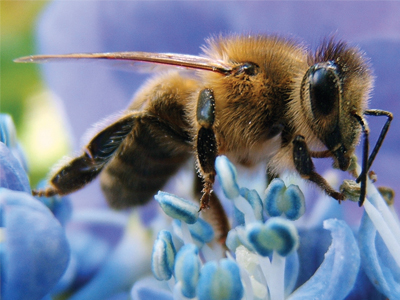MCP: We shall know thine enemy, honey bee
Varroa destructor is appropriately named, given the havoc it wreaks on colonies of western honey bees. Since it first arrived in Florida in the 1980s, the parasitic mite has pushed bee colonies across North America to ruin, and it is believed to be the most significant contributor to the recent spike in colony deaths in the United States and . Despite the scope of the mite’s damage, however, surprisingly little is known about its inner molecular workings.
 A western honey bee rests on a flower. RICKS/WIKIMEDIA COMMONS
A western honey bee rests on a flower. RICKS/WIKIMEDIA COMMONS
As a first step in ultimately combating this bee-barian, researchers in the lab of at the University of British Columbia in Canada have published in Molecular & Cellular Proteomics that details 1,433 differentially expressed proteins across the various developmental stages of V. destructor.
“One thing that a lot of people who are studying model systems or human systems don’t really appreciate is that when you move outside of those model systems and try to understand something at a molecular level about an organism without that huge body of knowledge that has been built over the years in that particular organism, you really don’t have any idea where to start,” Foster said. With this in mind, Foster and colleagues, including graduate student Alison McAfee, set out to create a document of the entire proteome that the male and female mites might produce throughout their life cycles.
“It’s a tool that other researchers can use to come up with their own questions about Varroa biology,” said McAfee, whose research focuses on the defense mechanisms bees mount against the mites.
In addition to quantifying the mites’ proteins, the researchers found that males and females expressed proteins involved in chromatin remodeling differently.
“Very little is known about the sex determination system in Varroa,” McAfee said. “Part of what that might be pointing to is the mites exposing different parts of the DNA to express more sex-specific proteins.”
The harm that V. destructor inflicts on honey bees is multifold; in addition to feasting on the bees’ blood and leaving open wounds ripe for infection, the mites are vectors for the deformed wing virus, which cripples wing growth in developing honey-bee pupae.
The scope of damage from mites is a consequence of abrupt introductions — the longer a host and parasite have coexisted and coevolved, the more harmonious, if still exploitative, their relationship will be.
Such is the case with V. destructor and its original host, the Asian honey bee, which have had millions of years to get to know one another. However, V. destructor and its viruses have just barely begun to make evolutionary introductions with honey bees, giving their new hosts few genetic weapons to fight them off.
According to Foster, Varroa’s use of odorant-binding proteins is likely key to their predatory interactions.
“Varroa have to be able to detect bees of certain ages, and this has to depend on odors,” he said. “At some point, we will want to try to define the molecular mechanism that is underlying that interaction, and knowing which proteins are expressed in which stages in the Varroa will be important for that eventual understanding.”
Enjoy reading 91—«…´¥´√Ω Today?
Become a member to receive the print edition four times a year and the digital edition monthly.
Learn moreGet the latest from 91—«…´¥´√Ω Today
Enter your email address, and we’ll send you a weekly email with recent articles, interviews and more.
Latest in Science
Science highlights or most popular articles

Bacterial enzyme catalyzes body odor compound formation
Researchers identify a skin-resident Staphylococcus hominis dipeptidase involved in creating sulfur-containing secretions. Read more about this recent Journal of Biological Chemistry paper.

Neurobiology of stress and substance use
MOSAIC scholar and proud Latino, Bryan Cruz of Scripps Research Institute studies the neurochemical origins of PTSD-related alcohol use using a multidisciplinary approach.

Pesticide disrupts neuronal potentiation
New research reveals how deltamethrin may disrupt brain development by altering the protein cargo of brain-derived extracellular vesicles. Read more about this recent Molecular & Cellular Proteomics article.

A look into the rice glycoproteome
Researchers mapped posttranslational modifications in Oryza sativa, revealing hundreds of alterations tied to key plant processes. Read more about this recent Molecular & Cellular Proteomics paper.

Proteomic variation in heart tissues
By tracking protein changes in stem cell–derived heart cells, researchers from Cedars-Sinai uncovered surprising diversity — including a potential new cell type — that could reshape how we study and treat heart disease.

Parsing plant pigment pathways
Erich Grotewold of Michigan State University, an 91—«…´¥´√Ω Breakthroughs speaker, discusses his work on the genetic regulation of flavonoid biosynthesis.

